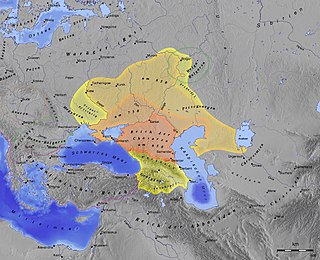
The Khazars were a nomadic Turkic people that, in the late 6th-century CE, established a major commercial empire covering the southeastern section of modern European Russia, southern Ukraine, Crimea, and Kazakhstan. They created what for its duration was the most powerful polity to emerge from the break-up of the Western Turkic Khaganate. Astride a major artery of commerce between Eastern Europe and Southwestern Asia, Khazaria became one of the foremost trading empires of the early medieval world, commanding the western marches of the Silk Road and playing a key commercial role as a crossroad between China, the Middle East and Kievan Rus'. For some three centuries the Khazars dominated the vast area extending from the Volga-Don steppes to the eastern Crimea and the northern Caucasus.
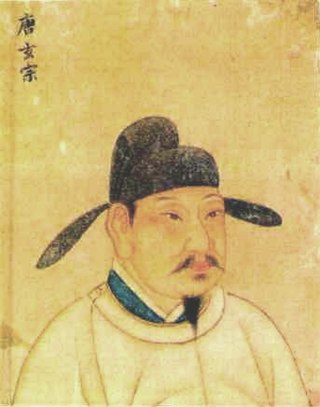
Year 730 (DCCXXX) was a common year starting on Sunday of the Julian calendar. The denomination 730 for this year has been used since the early medieval period, when the Anno Domini calendar era became the prevalent method in Europe for naming years.
Atil, also Itil, was the capital of the Khazar Khaganate from the mid-8th century to the late 10th century. Known to have been situated on the Silk Road, in the vicinity of the Caspian Sea, its precise location has long been unknown.
Bulan was a Khazar king who led the conversion of the Khazars to Judaism. His name means "elk" or "hart" in Old Turkic. The date of his reign is unknown, as the date of the conversion is hotly disputed, though it is certain that Bulan reigned some time between the mid-8th and the mid-9th centuries. Nor is it settled whether Bulan was the Bek or the Khagan of the Khazars.
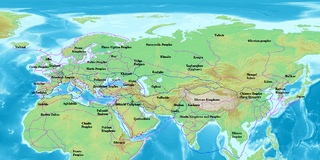
The Radhanites or Radanites were early medieval Jewish merchants, active in the trade between Christendom and the Muslim world during roughly the 8th to the 10th centuries. Many trade routes previously established under the Roman Empire continued to function during that period, largely through their efforts. Their trade network covered much of Europe, North Africa, the Middle East, Central Asia, and parts of India and China.
The Schechter Letter, also called the Genizah Letter or Cambridge Document, was discovered in the Cairo Geniza by Solomon Schechter in 1912. It is an anonymous Khazar letter discussing several matters including the wars of the early 940s, involving the Byzantine Empire, the Khazar Khaganate, and Kievan Rus'. Scholars have debated its authenticity.

Yitzhak ha-Sangari was the rabbi who purportedly converted the Khazar royalty to Judaism, according to medieval Jewish sources. According to D. M. Dunlop, "the name Isaac Sangari is perhaps not attested before the 13th century, when he is mentioned by Nahmanides."
ʿAbd al-Raḥmān ibn Rabīʿa al-Bāhilī was an Arab general of the Rashidun Caliphate, who led the Arab forces during the First Arab–Khazar War, until his death in battle in 652.
Maslama ibn Abd al-Malik was an Umayyad prince and one of the most prominent Arab generals of the early decades of the 8th century, leading several campaigns against the Byzantine Empire and the Khazar Khaganate. He achieved great fame especially for leading the second and last Arab siege of the Byzantine capital Constantinople.
The Battle of Marj Ardabil or the Battle of Ardabil was fought on the plains surrounding the city of Ardabil in northwestern Iran in AD 730. A Khazar army led by Barjik, the son of the Khazar khagan, invaded the Umayyad provinces of Jibal and Iranian Azerbaijan in retaliation for Caliphate attacks on Khazaria during the course of the decades-long Khazar-Arab War of the early 8th century.
The Battle of Bajarwan took place during the Second Arab–Khazar War, between the armies of the Khazar Khaganate, led by the khagan's son Barjik, and the Umayyad Caliphate, whose commanding general was Sa'id ibn Amr al-Harashi.
The Battle of Balanjar took place during the First Khazar-Arab War between the armies of the Khazar Khaganate and the Caliphate, whose commanding general was Abd ar-Rahman ibn Rabiah.
The Battle of Balanjar took place during the Khazar–Arab Wars. In 722 or 723, according to Muhammad ibn Jarir al-Tabari, Umayyad soldiers under al-Jarrah ibn Abdallah crossed the Caucasus Mountains and attacked Balanjar. The inhabitants of Balanjar tried to defend their town by fastening 300 wagons together and circling them around the key fortress on high terrain, but were defeated in the attack. The Arabs massacred much of the town's population; survivors fled to other towns, including Samandar. The victorious Arab army stole much booty and the soldiers received large sums of money. After this battle, the Arabs went on to capture Samandar and the Muslims once again became a dominant force in Transcaucasia.
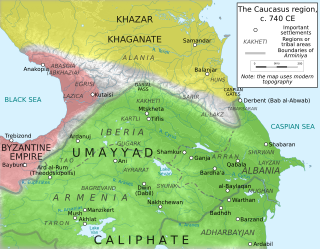
The Arab–Khazar wars were a series of conflicts fought between the Khazar Khaganate and successive Arab caliphates in the Caucasus region from c. 642 to 799 CE. Smaller native principalities were also involved in the conflict as vassals of the two empires. Historians usually distinguish two major periods of conflict, the First Arab–Khazar War and Second Arab–Khazar War ; the wars also involved sporadic raids and isolated clashes from the mid-seventh century to the end of the eighth century.
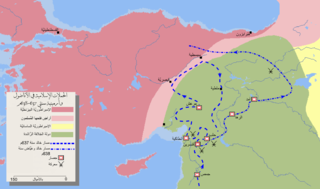
The Muslim conquest of Armenia was a part of the Muslim conquests after the death of the Islamic prophet Muhammad in 632 CE. Persarmenia had fallen to the Arab Rashidun Caliphate by 645 CE. Byzantine Armenia was already conquered in 638–639.
Alania was a medieval kingdom of the Iranian Alans (Proto-Ossetians) that flourished between the 9th–13th centuries in the Northern Caucasus, roughly in the location of latter-day Circassia, Chechnya, Ingushetia, and modern North Ossetia–Alania. With its capital at Maghas, the location of which is still disputed, it became independent from the Khazars in the late 9th century. It was Christianized by a Byzantine missionary soon after, in the early 10th century.

Arab rule in Georgia, natively known as Araboba refers to the period in the History of Georgia when parts of what is now Georgia came under Arab rule, starting with the first Arab incursions in the mid-7th century until the final defeat of the Emirate of Tbilisi at the hands of King David IV in 1122. Compared with other regions which endured Muslim conquests, Georgia's culture, and even political structure was not much affected by the Arab presence, as the people kept their faith, the nobles their fiefdoms, and the foreign rulers mostly insisted on the payment of tribute, which they could not always enforce. Still, repeated invasions and military campaigns by the Arabs devastated Georgia on many occasions, and the Caliphs retained suzerainty over significant parts of the country and exerted influence over the internal power dynamics during most of the period.

The Khazar hypothesis of Ashkenazi ancestry, often called the Khazar myth by its critics, is a largely abandoned historical hypothesis that postulated that Ashkenazi Jews were primarily, or to a large extent, descended from Khazars, a multi-ethnic conglomerate of mostly Turkic peoples who formed a semi-nomadic khanate in and around the northern and central Caucasus and the Pontic–Caspian steppe. The hypothesis also postulated that after collapse of the Khazar empire, the Khazars fled to Eastern Europe and made up a large part of the Jews there. The hypothesis draws on medieval sources such as the Khazar Correspondence, according to which at some point in the 8th–9th centuries, a small number of Khazars were said by Judah Halevi and Abraham ibn Daud to have converted to Rabbinic Judaism. The scope of the conversion within the Khazar Khanate remains uncertain, but the evidence used to tie the subsequent Ashkenazi communities to the Khazars is meager and subject to conflicting interpretations.
In the history of Azerbaijan, the Early Middle Ages lasted from the 3rd to the 11th century. This period in the territories of today's Azerbaijan Republic began with the incorporation of these territories into the Sasanian Persian Empire in the 3rd century AD. Feudalism took shape in Azerbaijan in the Early Middle Ages. The territories of Caucasian Albania became an arena of wars between the Byzantine Empire and the Sassanid Empire. After the Sassanid Empire was felled by the Arab Caliphate, Albania also weakened and was overthrown in 705 AD by the Abbasid Caliphate under the name of Arran. As the control of the Arab Caliphate over the Caucasus region weakened, independent states began to emerge in the territory of Azerbaijan.







